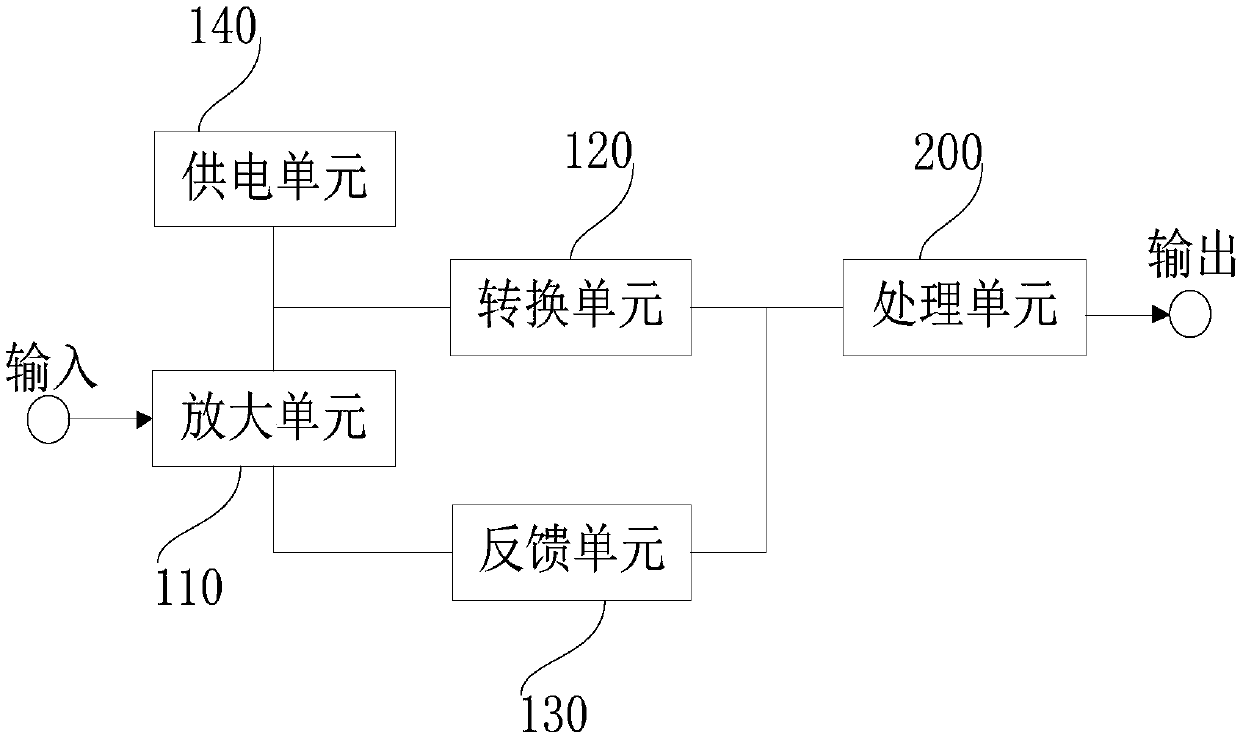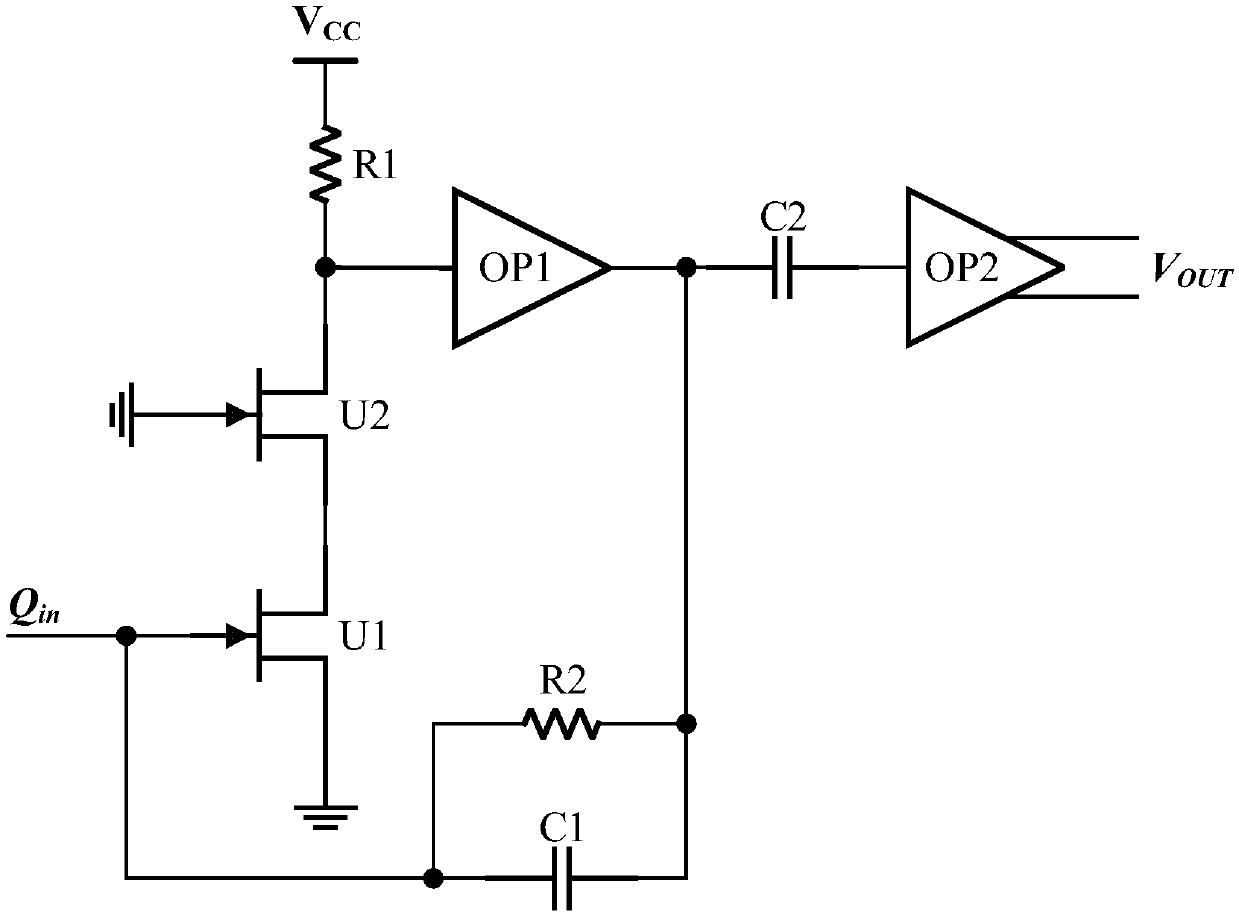Charge voltage conversion amplification circuit and electronic device
A charge-voltage conversion and amplifying circuit technology, which is applied to charge amplifiers, components of amplifying devices, and negative feedback circuit layout, etc., can solve problems such as submersion of charge signals, and achieve the effect of improving performance indicators and increasing the success rate of processing.
- Summary
- Abstract
- Description
- Claims
- Application Information
AI Technical Summary
Problems solved by technology
Method used
Image
Examples
Embodiment 1
[0028] see figure 1 , the charge-to-voltage conversion amplifier circuit includes an amplification unit 110 , a conversion unit 120 , a feedback unit 130 and an output unit 200 .
[0029] The input terminal of the amplification unit 110 is used to connect the detector and amplify the charge signal output by the detector; the input terminal of the conversion unit 120 is connected to the output terminal of the amplification unit 110, and is used to convert the charge signal amplified by the amplification unit 110 into a preset Standard voltage signal; the input end of the feedback unit 130 is connected to the output end of the conversion unit 120 , and the output end is connected to the input end of the amplification unit 110 . The amplifying unit, the converting unit and the feedback unit form a closed loop, and the output terminal signal is fed back to the input terminal, which can improve the performance index of the amplifying circuit. The input end of the output unit 200 i...
Embodiment 2
[0039] Such as figure 1 As shown, the charge-to-voltage conversion amplifier circuit includes an amplification unit 110 , a conversion unit 120 , a feedback unit 130 and an output unit 200 .
[0040] The input terminal of the amplification unit 110 is used to connect the detector and amplify the charge signal output by the detector; the input terminal of the conversion unit 120 is connected to the output terminal of the amplification unit 110, and is used to convert the charge signal amplified by the amplification unit 110 into a preset Standard voltage signal; the input end of the feedback unit 130 is connected to the output end of the conversion unit 120 , and the output end is connected to the input end of the amplification unit 110 . The amplifying unit, the converting unit and the feedback unit form a closed loop, and the output terminal signal is fed back to the input terminal, which can improve the performance index of the amplifying circuit. The input end of the outpu...
Embodiment 3
[0050] see figure 1 As shown, the charge-to-voltage conversion amplifier circuit includes an amplification unit 110 , a conversion unit 120 , a feedback unit 130 and an output unit 200 .
[0051] The input terminal of the amplification unit 110 is used to connect the detector and amplify the charge signal output by the detector; the input terminal of the conversion unit 120 is connected to the output terminal of the amplification unit 110, and is used to convert the charge signal amplified by the amplification unit 110 into a preset Standard voltage signal; the input end of the feedback unit 130 is connected to the output end of the conversion unit 120 , and the output end is connected to the input end of the amplification unit 110 . The amplifying unit, the converting unit and the feedback unit form a closed loop, and the output terminal signal is fed back to the input terminal, which can improve the performance index of the amplifying circuit. The input end of the output un...
PUM
 Login to View More
Login to View More Abstract
Description
Claims
Application Information
 Login to View More
Login to View More - R&D
- Intellectual Property
- Life Sciences
- Materials
- Tech Scout
- Unparalleled Data Quality
- Higher Quality Content
- 60% Fewer Hallucinations
Browse by: Latest US Patents, China's latest patents, Technical Efficacy Thesaurus, Application Domain, Technology Topic, Popular Technical Reports.
© 2025 PatSnap. All rights reserved.Legal|Privacy policy|Modern Slavery Act Transparency Statement|Sitemap|About US| Contact US: help@patsnap.com



